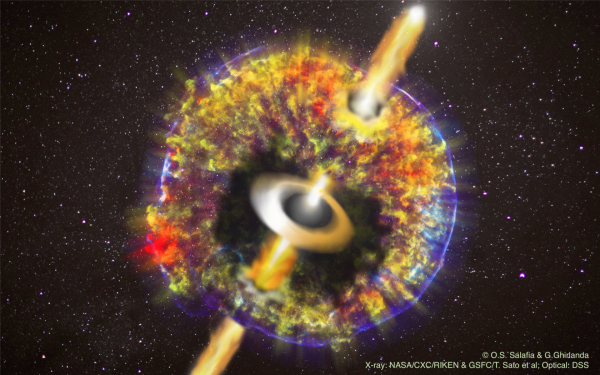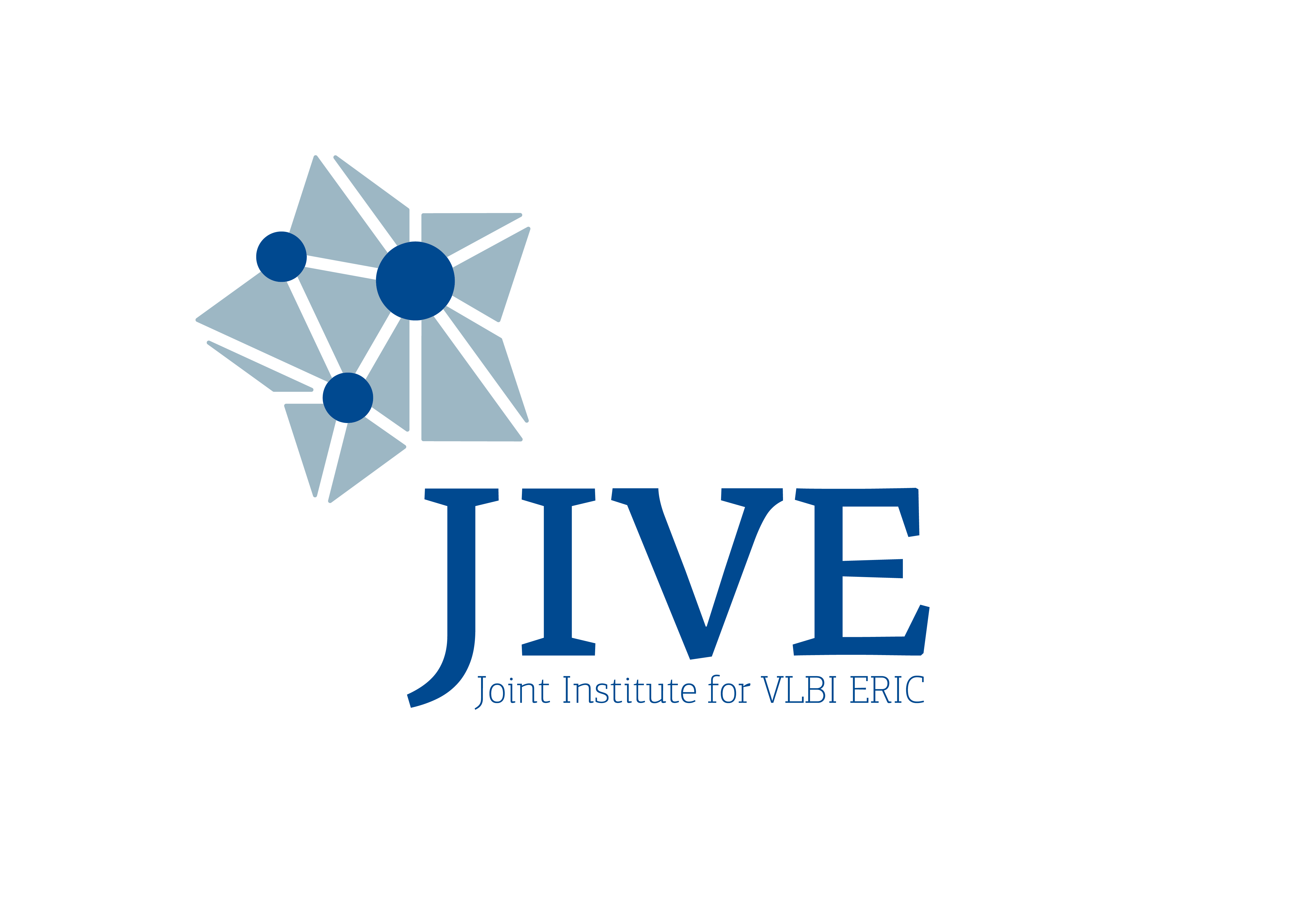
Image Credit: O.S Salafia & G. Ghirlanda | X ray: NASA/CXC/RIKEN & GSFC/T. Sato et al. | Optical: SDSS.
On Tuesday 29 June 2021, the Special Session "Extreme astrophysics at extremely high resolution" will highlight the latest scientific results of high-resolution radio instruments, such as the European VLBI Network (EVN) and similar arrays, with particular focus on the synergies with high resolution and high energy phenomena across the electromagnetic spectrum. The session is being organised with the support of the H2020 JUMPING JIVE project as part of the European Astronomical Society 2021 (EAS 2021) Annual Meeting held virtually from 28 June to 2 July 2021.
The main goal of the session is to highlight the scientific possibilities that can be achieved when joining VLBI with other observational techniques, from the connection between radio-jets and neutrino emission, to the latest observations of Fast Radio Bursts and stellar evolution. The online EAS 2021 Special Session will comprise a wide range of presentations covering the current hot topics of multi-wavelength and multi-messenger astrophysics: several invited talks of 25 minutes and solicited talks of 15 minutes, by a range of experts invited by the SOC. In addition, it will include a limited number of brief contributed talks and 1-minute ePoster presentations.
Programme
SS11a: Extreme astrophysics at extremely high resolution | 29 June 09:00 - 10:30 CEST
- Chair: Sara Issaoun, Radboud University, Netherlands
- Facilitator: Ilse van Bemmel, JIVE, Netherlands
09:00 - 09:02 CEST - Welcome and announcements
09:02 - 09:27 CEST- A polarimetric view of black hole accretion flows and jets | Monika Moscibrodzka - Radboud University, Nijmegen, Netherlands
09:27 - 09:52 CEST - Zooming into the heart of Centaurus A with the Event Horizon Telescope | Michael Janssen - Max Planck Institute for Radio Astronomy, Bonn, Germany
09:52 - 10:07 CEST - Multi-wavelength View of the M 87 Black Hole captured by Event Horizon Telescope | Dorit Glawion - ECAP, FAU Erlangen-Nürnberg, Erlangen, Germany
10:07 - 10:16 CEST - AGN jet boundary shape break – what can we learn about the central engine? | Elena Nokhrina - Moscow Institute Of Physics And Technology, Dolgoprudny, Russian Federation
10:16 - 10:25 CEST - The helical magnetic field in the bent jet of OJ287 through radio and optical variable polarisation | Emmanouil Angelakis - University of Athens, Athens, Greece
10:25 - 10:30 CEST ePoster short Presentations
SS11b: Extreme astrophysics at extremely high resolution | 29 June 11:00 - 12:30 CEST
- Chair: Anna Franckowiak, Ruhr-university Bochum, Germany
- Panelist: Ilse van Bemmel, JIVE, Netherlands
11:00 - 11:20 CEST - VLBI: the key to the origin of cosmic neutrinos | Alexander Plavin - Astro Space Center of Lebedev Physical Institute, Moscow, Russian Federation / Moscow Institute of Physics and Technology, Moscow, Russian Federation
11:20 - 11:40 CEST - Neutrinos from Tidal Disruption Events | Robert Stein - DESY Zeuthen, Germany
11:40 - 12:05 CEST - GW170817: the show is still on | Raffaella Margutti - Northwestern University, United States
12:05 - 12:23 CEST - VLBI observations of nearby GRB 190829A: a superluminal jet expanding in a low-density medium (No 796) | Jun Yang - Department of Space, Earth and Environment, Chalmers University of Technology, Onsala Space Observatory, Onsala, Sweden
12:23 - 12:30 CEST - ePoster short Presentations
SS11c: Extreme astrophysics at extremely high resolution | 29 June 16:30 - 18:00 CEST
- Chair: Anna Bartkiewicz, Torun Institute Of Astronomy, Poland
- Panelist: Ilse van Bemmel, JIVE, Netherlands
- Facilitator: Manisha Caleb, University of Manchester, United Kingdom
16:30 - 16:53 CEST Fast radio bursts with VLBI | Kenzie Nimmo - ASTRON, Netherlands / University of Amsterdam, Netherlands
16:53 - 17:16 CEST - Into the maze(r): highlighting the dark corners of star formation | Olga Bayandina - The Joint Institute for VLBI ERIC, Netherlands / Astro Space Center of P.N. Lebedev Physical Institute of RAS, Russia
17:16 - 17:29 CEST - VLBI and Gaia Astrometry of Mira Variables: Implication to Period-Luminosity Relation of the Milky Way | James Chibueze - North-West University, Potchefstroom, South Africa
17:29 - 17:42 CEST - The Galactic fast radio burst source SGR1935+2154 -- what does it take to be called an FRB? | Franz Kirsten - Chalmers University Of Technology, Sweden
17:42 - 17:51 CEST - The Orion Radio All-Stars: High-energy processes in YSOs with the VLA, ALMA and the VLBA. | Jaime Vargas-González - University of Hertfordshire, Hatfield, United Kingdom
17:51 - 17:56 CEST - ePoster short Presentations
17:56 - 18:00 CEST - Session wrap up | Ilse van Bemmel, JIVE, Netherlands
For more details on the session, including the presentation's abstracts, please visit the EAS 2021 interactive programme.
Scientific organisers
- Ilse van Bemmel (JIVE, Netherlands, co-chair)
- Kazi Rygl (INAF - IRA, Italy, co-chair)
- Anna Bartkiewicz (Nicolaus Copernicus University, Torun, Poland)
- Manisha Caleb (Manchester University, United Kingdom)
- Anna Franckowiak (Ruhr-University Bochum, Germany)
- Giancarlo Ghirlanda (OABrera - INAF, Italy)
- Sara Issaoun (Radboud University, Nijmegen, Netherlands)
This event has received funding from the European Union's Horizon 2020 research and innovation programme under grant agreement No 7308844 (JUMPING JIVE).
European Astronomical Society 2021 Meeting
The European Astronomical Society (EAS) Annual Meeting has more than 25 years of tradition and it has imposed itself as the largest conference for European astronomy. In addition to plenary sessions and the award of prestigious prizes, the conference hosts many symposia held in parallel, as well as special sessions and meetings.
After the shift to an EAS 2020 virtual meeting, EAS 2021 should have been held physically in Leiden, The Netherlands. Due to the uncertain COVID-19 situation in Europe and the world, the meeting was (again) moved to a virtual meeting, resulting in the registration of over 2000 participants so far.
More information about the EAS 2021 Conference can be found here.
Additional information
The H2020 JUMPING JIVE project aims to take Very Long Baseline Interferometry (VLBI) into the next decade, with JIVE and the European VLBI Network (EVN) as globally recognized centres of excellence in radio astronomy. The project brings together scientists and engineers to define the future of VLBI for scientific applications, and identify the required technological innovation to realise such a future. JIVE is leading the project and twelve institutes from eight different European countries have teamed up in JUMPING JIVE.
The Joint Institute for VLBI ERIC (JIVE) has as its primary mission to operate and develop the EVN data processor, a powerful supercomputer that combines the signals from radio telescopes located across the planet. Founded in 1993, JIVE is since 2015 a European Research Infrastructure Consortium (ERIC) with seven member countries: France, Italy, Latvia, the Netherlands, United Kingdom, Spain and Sweden; additional support is received from partner institutes in China, Germany and South Africa. JIVE is hosted by the Netherlands Institute for Radio Astronomy (ASTRON) in the Netherlands.
Contact
Ilse van Bemmel
JUMPING JIVE Project Scientist
bemmel@jive.eu
Giuseppe Cimò
JIVE Space VLBI Scientist
JUMPING JIVE Project Manager
cimo@jive.eu
Jorge Rivero González
JIVE Science Communications Officer
rivero@jive.eu
